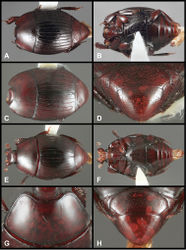Crenulister spinipes
| Notice: | This page is derived from the original publication listed below, whose author(s) should always be credited. Further contributors may edit and improve the content of this page and, consequently, need to be credited as well (see page history). Any assessment of factual correctness requires a careful review of the original article as well as of subsequent contributions.
If you are uncertain whether your planned contribution is correct or not, we suggest that you use the associated discussion page instead of editing the page directly. This page should be cited as follows (rationale):
Citation formats to copy and paste
BibTeX: @article{Caterino2014ZooKeys381, RIS/ Endnote: TY - JOUR Wikipedia/ Citizendium: <ref name="Caterino2014ZooKeys381">{{Citation See also the citation download page at the journal. |
Ordo: Coleoptera
Familia: Histeridae
Genus: Crenulister
Name
Crenulister spinipes Caterino & Tishechkin, 2014 sp. n. – Wikispecies link – ZooBank link – Pensoft Profile
Type locality
FRENCH GUIANA: Réserve des Nouragues [4.038°N, 52.673°W].
Type material
Holotype female: “GUYANE FRANÇAISE: Régina, Réserve des Nouragues, 4°2.27'N, 52°40.35'W, Piége d’interception, 28 Jan 2010. SEAG leg.” / “Caterino/Tishechkin Exosternini Voucher EXO-00181” (MNHN). Paratypes (2): 1: Belvèdére de Saül, point de vue, 3°1'22"N, 53°12'34"W, 4.i.2011, FIT, SEAG (CHND); 1: Montagne des Chevaux, 4°43'N, 52°24'W, 26.xii.2008, FIT, SEAG (FMNH)
Diagnostic description
Length: 2.4–2.6 mm, width: 2.2–2.4 mm; as for generic description with the following diagnostic characters: body rufobrunneus, elongate ovoid, moderately convex; frontal stria fine but complete across middle, frontal disk rather strongly depressed, with sparse secondary punctures rather evenly distributed on frons and epistoma; epistoma with oblique lateral ridges delimiting median depression bearing faint traces of striae basally; labrum about 4× wider than long, apical margin shallowly, broadly emarginate; pronotum with gland opening track extending posterad just beyond midpoint, with 3-4 openings along its length; pronotal sides moderately explanate along very weakly crenulate lateral submarginal stria; pronotal disk with numerous, large secondary punctures in basal third, most strongly concentrated at middle, sides largely smooth; prescutellar impression not evident; elytron with one complete, crenulate epipleural stria and second incomplete stria closer to margin in posterior half, all dorsal striae complete, moderately coarsely impressed, appearing chain-like; elytral intervals sparsely, irregularly punctate, most intervals with 12–18 punctures; prosternal keel with complete, narrowly anteriorly united carinal striae; prosternal lobe with marginal stria present only at middle; mesoventrite with marginal stria weakly crenulate, mesometaventral stria similarly so, subangulately arched forward just beyond mesoventral midpoint; postmesocoxal stria slightly recurved anterad around mesocoxa but ending short of mesepimeron; lateral metaventral stria crenulate, reaching middle of metacoxa; mesoventrite entirely and more or less uniformly coarsely punctate; metepisternal punctures coalescing into a short longitudinal stria; punctures of 1st abdominal ventrite mostly uniform, slightly obliquely elongate posterad metacoxa, transversely elongate along posterior margin, intermittently coalesced into marginal strioles, as are those of ventrites 2–4; protibia 7–8-spined, with marginal dentation very weakly developed; meso- and metatibiae with 4–5 spines each, mainly in apical half; propygidium with secondary punctures shallow, sparse, separated by 1–2× their diameters throughout; propygidial gland opening associated with weak oblique striole in anterior corners; pygidial punctation sparse, punctures slightly smaller than those of propygidium, more or less uniformly separated by 2–3× their diameters throughout; pygidial gland openings evident at sides about one-fourth from base, marginal striae present along sides, broadly interrupted at apex. Male: not known.
Remarks
This species and Crenulister grossus are very similar and evidently closely related. The smaller size, less coarsely impressed elytral striae (Fig. 19C), and semistriate metepisternum, abdominal ventrites and propygidium (Fig. 19D) will distinguish this species readily. Although both are larger than average for the genus, Crenulister grossus is still markedly larger.
Etymology
The name of this species refers to its conspicuously spinose protibiae.
Original Description
- Caterino, M; Tishechkin, A; 2014: New genera and species of Neotropical Exosternini (Coleoptera, Histeridae) ZooKeys, 381: 11-78. doi
Images
|

